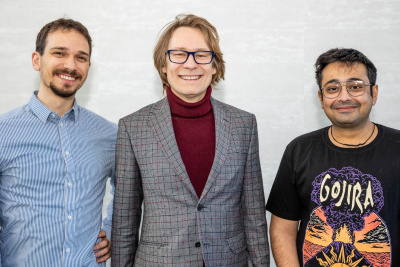
A team of three scientists from the University of Gdańsk has developed an innovative system for generating symmetric cryptographic keys and random numbers, which has been patented by the Polish Patent Office. The invention is a response to growing cyber security requirements, as it allows for the highest level of encryption security (e.g. in communication, data protection or critical infrastructure security) at a relatively low cost.
The invention was developed by researchers from the International Centre for Theory Of Quantum Technologies (ICTQT): Head of the Quantum Cybersecurity Team dr hab. Marcin Pawłowski, prof. UG, dr Anubhav Chaturvedi and dr Giuseppe Viola. The process of intellectual property protection at the University of Gdańsk was coordinated by a team of experts from the Technology Transfer Office at the University of Gdańsk.
The proposed solution consists of a central unit (which contains the source of entanglement - a quantum state generator), an intermediary unit, and end users, of which there may be many. The cryptographic key used to encrypt data is generated through the cooperation of all three units, which eliminates the risks associated with the need to transfer the key:
‘The device uses the most advanced version of quantum cryptography, in which cryptographic keys do not exist until they are measured by users, so they cannot be intercepted in any way. In addition, the device continuously tests the quality of the cryptographic keys it creates during operation and automatically detects attacks or faults,’ says prof. Marcin Pawłowski.
Significant problems with quantum cryptography to date have been the short range of devices, low resistance to noise in communication channels, and very high requirements for photon detection efficiency. The invention by scientists from the University of Gdańsk, which is part of the latest ‘device-independent quantum cryptography,’ significantly eliminates these problems. The system ensures a high level of security for encrypted information while maintaining high efficiency and relatively low cost: the hardware requirements for the central transmitter are relatively high, while the hardware requirements for the receivers are much lower. As a result, the cost of the device for the end user is lower than at present, while the range is increased from hundreds of metres to approximately 100 km.
The system allows a large number of users to connect via a central node. What is more, the network administrator can decide whether any pair of users is protected against any type of eavesdropping, or whether eavesdropping by the node is permitted, which is in line with current trends in cybersecurity.
The invention has high implementation potential:
‘Our system provides cryptographic keys for communication with the highest level of security and can be used wherever such a level is required. This is primarily for securing critical infrastructure and transmitting highly confidential information,’ comments prof. Marcin Pawłowski.
A full description of the invention can be found here (in Polish).
